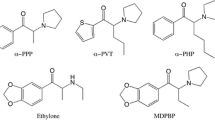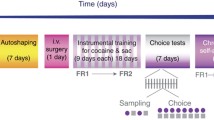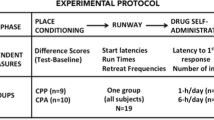Abstract
Rationale
Methamphetamine (METH) is typically characterized as a more potent psychostimulant than amphetamine (AMPH), but few studies have directly compared the effects of these drugs at low, behaviorally activating doses that tend not to produce focused stereotypy.
Objectives
The objective of the study was to compare the effects of AMPH or METH treatment on locomotor activity in an open-field arena, focusing on their ability to produce conditioned locomotor activity, sensitization, and cross-sensitization.
Materials and methods
Adult male rats were given AMPH or METH (0.5 or 1.0 mg/kg) for 5 days, with half of the rats presented with discrete, salient stimuli (S+) during the postinjection period. After a 3-day withdrawal, they were given three different injections on successive days: a saline challenge to assess conditioned responding, a drug challenge to assess sensitization, and a cross-sensitization test to the same dose of the drug with which they were not pretreated.
Results
Except in certain conditions, AMPH and METH were equipotent at activating locomotor activity. The exceptions included when rats were presented with S+ on acute and drug challenge days and in tests of cross-sensitization. There were no consistent differences in the magnitude of sensitization produced by AMPH or METH, and both drugs produced similar amounts of conditioned locomotion after a saline injection.
Conclusions
We have found specific conditions where METH is more potent than AMPH, but this study and others that used higher doses of these drugs are not consistent with the generalized characterization of METH as a more potent psychostimulant.




Similar content being viewed by others
References
Archer J (1973) Tests for emotionality in rats and mice: a review. Anim Behav 21:205–235
Badiani A, Robinson TE (2004) Drug-induced neurobehavioral plasticity: the role of plasticity. Behav Pharm 15:327–339
Balster RL, Schuster CR (1973) A comparison of d-amphetamine, l-amphetamine, and methamphetamine self-administration in rhesus monkeys. Pharmacol Biochem Behav 1:67–71
Bevins RA, Peterson JL (2004) Individual differences in rats’ reactivity to novelty and the unconditioned and conditioned locomotor effects of methamphetamine. Pharmacol Biochem Behav 79:65–74
Bevins RA, Klebaur JE, Bardo MT (1997) Individual differences in response to novelty, amphetamine-induced activity and drug discrimination in rats. Behav Pharm 8:113–123
Carey RJ, Damianopoulos EN (2006) Cocaine conditioning and sensitization: the habituation factor. Pharmacol Biochem Behav 84:128–133
Colliver JD, Kroutil LA, Dai L, Gfroerer JC (2006) Misuse of prescription drugs: data from the 2002, 2003, and 2004 national surveys on drug use and health. Substance Abuse and Mental Health Services Administration, Office of Applied Studies, Rockville, MD
Crombag HS, Badiani A, Maren S, Robinson TE (2000) The role of contextual versus discrete drug-associated cues in promoting the induction of psychomotor sensitization to intravenous amphetamine. Behav Brain Res 116:1–22
Feldman RS, Meyer JS, Quenzer LF (1997) Stimulants: amphetamine and cocaine (Principles of Neuropsychopharmacology). Sinauer, Sunderland, MA
Gentry WB, Ghafoor AU, Wessinger WD, Laurenzana EM, Hendrickson HP, Owens SM (2004) (+)-Methamphetamine-induced spontaneous behavior in rats depends on route of (+)METH administration. Pharmacol Biochem Behav 79:751–760
Hooks MS, Jones GH, Smith AD, Neill DB, Justice JB (1991) Individual differences in locomotor activity and sensitization. Pharmacol Biochem Behav 38:467–470
Hooks MS, Jones GH, Neill DB, Justice JB (1992) Individual differences in amphetamine sensitization: dose-dependent effects. Pharmacol Biochem Behav 41:203–210
Hotsenpiller G, Giorgetti M, Wolf ME (2001) Alterations in behaviour and glutamate transmission following presentation of stimuli previously associated with cocaine exposure. Eur J Neurosci 14:1843–1855
Kuczenski R, Segal D (2002) Exposure of adolescent rats to oral methylphenidate: preferential effects on extracellular norepinephrine and absence of sensitization and cross-sensitization to methamphetamine. J Neurosci Aug 15; 22:7264–7271
Kuczenski R, Segal D, Cho A, Melega W (1995) Hippocampus norepinephrine, caudate dopamine and serotonin, and behavioral responses to the stereoisomers of amphetamine and methamphetamine. J Neurosci 15:1308–1317
Kuhn DM, Appel JB, Greenberg I (1974) An analysis of some discriminative properties of d-amphetamine. Pharmacologia 39:57–66
Lamb RJ, Henningfield JE (1994) Human d-amphetamine drug discrimination: methamphetamine and hydromorphone. J Exp Anal Behav 61:169–180
Melega W, Williams A, Schmitz D, DiStefano E, Cho A (1995) Pharmacokinetic and pharmacodynamic analysis of the actions of D-amphetamine and D-methamphetamine on the dopamine terminal. J Pharmacol Exp Ther 274:90–96
Milesi-Hallé A, McMillan DE, Laurenzana EM, Byrnes-Blake KA, Owens SM (2007) Sex differences in (+)-amphetamine- and (+)-methamphetamine-induced behavioral response in male and female Sprague–Dawley rats. Pharmacol Biochem Behav 86:140–149
NIDA Research Report (2006) Methamphetamine abuse and addiction. NIH Publication no. 06-4210, pp 1–8
Panlilio LV, Schindler CW (1997) Conditioned locomotor-activating and reinforcing effects of discrete stimuli paired with intra-peritoneal cocaine. Behav Pharmacol 8:691–698
Rawson RA, Condon TP (2007) Why do we need an Addiction supplement focused on methamphetamine? Addiction 102:1–4
Rebec GV, Bashore TR (1984) Critical issues in assessing the behavioral effects of amphetamine. Neurosci Biobehav Rev 8:153–159
Romanelli F, Smith KM (2006) Clinical effects and management of methamphetamine abuse. Pharmacotherapy 26:1148–1156
Sabeti J, Gerhardt GA, Zahniser NR (2003) Individual differences in cocaine-induced locomotor sensitization in low and high cocaine locomotor-responding rats are associated with differential inhibition of dopamine clearance in nucleus accumbens. J Pharmacol Exp Ther 305:180–190
Segal D, Kuczenski R (1987) Individual differences in responsiveness to single and repeated amphetamine administration: behavioral characteristics and neurochemical correlates. J Pharmacol Exp Ther 242:917–926
Segal DS, Kuczenski R (1997) Repeated binge exposures to amphetamine and methamphetamine: behavioral and neurochemical characterization. J Pharmacol Exp Ther 282:561–573
Shoblock J, Sullivan E, Maisonneuve I, Glick S (2003) Neurochemical and behavioral differences between d-methamphetamine and d-amphetamine in rats. Psychopharmacology 165:369–369
Tilson HA, Rech RH (1973) Conditioned drug effects and absence of tolerance to d-amphetamine induced motor activity. Pharmacol Biochem Behav 1:149–153
Walsh RN, Cummins RA (1976) The open field test- a critical review. Psychol Bull 82:482–504
Yokel RA, Pickens R (1973) Self-administration of optical isomers of amphetamine and methylamphetamine by rats. J Pharmacol Exp Ther 187:27–33
Acknowledgments
The authors thank John P. Powers and Martin D. White for technical assistance. This work was funded by a grant from the National Institute on Drug Abuse (DA 01987).
Author information
Authors and Affiliations
Corresponding author
Rights and permissions
About this article
Cite this article
Hall, D.A., Stanis, J.J., Marquez Avila, H. et al. A comparison of amphetamine- and methamphetamine-induced locomotor activity in rats: evidence for qualitative differences in behavior. Psychopharmacology 195, 469–478 (2008). https://doi.org/10.1007/s00213-007-0923-8
Received:
Accepted:
Published:
Issue Date:
DOI: https://doi.org/10.1007/s00213-007-0923-8




